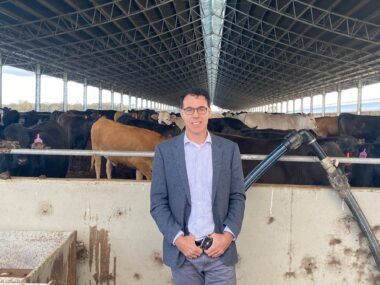An ambitious project, jointly managed by Bush Heritage Australia and Greening Australia, will help wildlife move across a globally recognised biodiversity hotspot by restoring a critical piece of habitat between the Fitzgerald River and the Stirling Range National Parks in southern Western Australia.
The project aims to restore 600 hectares of biodiverse habitat at Ediegarrup Reserve on Goreng Noongar Country by planting 150 species of native trees and shrubs over three years, which will provide habitat for threatened species such as Ngoolark (Carnaby’s Black Cockatoo) and Gnow (malleefowl).
Planting is already underway with 22,000 seedlings planted in 2023 and a further 61,000 seedlings planted in 2024. To date, over 200kg of local provenance native seed has also been sown by Greening Australia using direct seeding machines and tractors, representing many hundreds of thousands of seeds currently germinating and establishing across the landscape.
The world-class approach of this project is underpinned by high-integrity third party standards and reporting frameworks which will enable the actual impact of restoration efforts on environmental condition, biodiversity outcomes and carbon sequestration to be measured and communicated over time. These include standards and reporting set by Accounting for Nature (AfN), the Clean Energy Regulator (CER) for the generation of Australian Carbon Credit Units (ACCUs), and the Society of Ecological Restoration Australasia (SERA).
“Located in an extraordinarily culturally significant and biodiverse region that has over 1,500 endemic species of plants but that has lost more than 70 per cent of its original habitat,[1] this project sets a high standard for national and international carbon sequestration and restoration efforts,” said Alex Hams, Bush Heritage’s Healthy Landscape Manager.
“A typical carbon reforestation project will only plant a limited number of tree species. So what we’re doing is not just 'good for the climate' but also 'good for nature’.”
“In addition to the vast array of seedlings that will grow to provide critical habitat for nationally threatened species, we’ll install rock and log structures to increase the complexity of the habitat early on and encourage the return of small ground dwelling animals.”
Greening Australia’s Director of Impact Blair Parsons says that Australia needs projects like Ediegarrup on a massive scale to make genuine headway on the challenge of rebuilding nature, addressing climate change and turning the tide on the biodiversity crisis:
“We need to come together and think differently if we are to tackle a rapidly warming climate and chronic biodiversity loss. Our approach at Ediegarrup exemplifies what is needed to achieve the urgent impact required via restoration.
“We’re striving to build high-end restoration in an ecologically strategic location and make use of multiple environmental markets to support this work. Together, we’re going above and beyond in terms of design, implementation and experimental trials that aim to enhance the quality of habitats being established. Fundamental to this is tracking and demonstrating the biodiversity outcomes of the planting as well as carbon outcomes.”
The project team has carefully matched vegetation communities with historic and contemporary on-ground data, cultural heritage, soil types and future climate projections to commence the complex process of restoring the property towards its precleared state and ensuring that the habitat is resilient to a changing climate. Importantly, the team is also drawing on the substantial knowledge base that has been built up in the Gondwana Link region after decades of collective restoration effort.
Local Nowanup Rangers and Badgebup Aboriginal Rangers have been working alongside the Bush Heritage and Greening Australia teams to plant seedlings, which include species of bush foods found in the local area.
“It's been a wonderful journey to be a part of as the Noongar people, who were the first people connected to country,” said Eugene Eades, Goreng Noongar Elder
“I think it's great that we can bring our younger generation of people back on the country and teach them about cultural practices. Have them participate in the seed collecting, and germination of seeds, species of plant life. And then of course, learn more about the Noongar food, fruit, medicinal plants that need to be protected, as well”.
This partnership between Bush Heritage Australia and Greening Australia sets a new benchmark for restoration efforts at scale and showcases the value of collaboration by leaders in the environmental sector. By restoring vital habitat and protecting endangered species whilst sequestering carbon through a scalable market-based solution, this project is a significant step towards conserving Australia's unique biodiversity for future generations.
_______________
Click here for a video media pack.
Click here to access still images for print and online media.
[1] Western Australia’s Unique Biodiversity, The Western Australian Biodiversity Science Institute, available at: wabsi.org.au/our-work/was-unique-biodiversity/
About us:
About Bush Heritage Australia
Bush Heritage Australia is a leading not-for-profit conservation organisation that protects ecosystems and wildlife across the continent. We use the best science, conservation and right-way knowledge to deliver landscape-scale impact. We’re on the ground, working with Aboriginal and Torres Strait Islander people and the agricultural sector to make sure our impact is deep, sustainable and collaborative. For further information, please visit: www.bushheritage.org.au
About Greening Australia
Greening Australia has been restoring Australia’s unique landscapes and protecting biodiversity at scale through collaborative, science-based programs for over 40 years. Greening Australia is committed to tackling Australia’s greatest environmental challenges in ways that work for communities, economies and nature; planting millions of native trees and plants, protecting hundreds of native species, and supporting Traditional Owners’ aspirations for restoring Country. For more information, visit www.greeningaustralia.org.au.
Contact details:
For media enquiries, please contact Coco McGrath at Bush Heritage Australia or Emma Green at Greening Australia.
Coco McGrath: 0455 635 035
Emma Green: 0428 193 011

